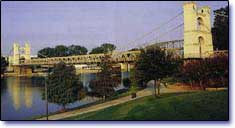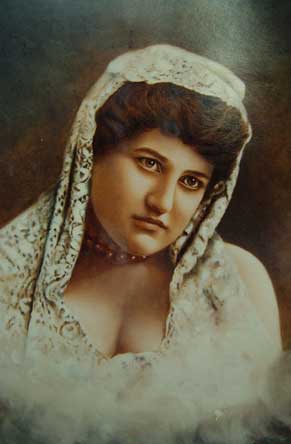

Places in Time

Roaring red light district part of Waco 's early history
By Carl Hoover, Waco Tribune-Herald
Nov. 14, 2005
As the 19th century turned into the 20th, Fort Worth had its Hell's Half Acre, San Antonio its District, Galveston its Post Office Street and Waco its Reservation.
They were red light districts of town where prostitutes worked and all operated outside the law – except in Waco .
From 1889 to 1917, Waco permitted prostitution in an area bounded by Washington Avenue, North Second Street, Jefferson Avenue and the Brazos River , a district just off downtown known as the Reservation, or informally as Two Street .
For a city that prided itself as the Athens of Texas, with its universities and numerous churches, the Reservation's existence was either the supreme irony or the highest hypocrisy.
City fathers rebuffed periodic efforts to close the district until Aug. 11, 1917, when Secretary of War Newton Baker ordered cities with military bases to shut down any red light districts to maintain the health of America 's soldiers.
Faced with the possible loss of Camp MacArthur and its 36,000 troops, Waco officials shut down the Reservation in August 1917, although some “sporting houses” were rumored to have operated through the 1920s.
An 1876 city directory noted that Matilda Davis, living at 76 N. Fourth St. , worked as a madam with 10 occupants in her house, the first record of a house of prostitution in Waco . Three years later, the first license for a “bawdy house” was issued.
Waco officials legalized prostitution within the Reservation in 1889 as a means of controlling it. House madams annually paid $12.50 for each bedroom and $10 for each “bawd or inmate.” Prostitutes had to pay an additional $10 license fee plus undergo a twice-monthly medical exam by the city physician at $2 per exam.
In her well-researched, 2005 master's thesis A Different Kind of Reservation: Waco's Red Light District Revisited; Baylor University graduate student Amy Balderach estimates that license fees, medical exams and city fines brought in the annual equivalent of $20,000 to $25,000 in today's dollars to the city – an amount surpassed by the considerable economic boost of Camp MacArthur.
City ordinances prevented prostitutes from straying beyond the Reservation's bounds.
Prostitutes and their madams – women apparently ran most sporting houses in the Reservation – had to sign the city's Bawdy House Register; if police found them outside the district, they could be arrested for vagrancy. They could not walk the few blocks to downtown Waco to shop; as a result, prostitutes had to hire horse-drawn cabs to take them to Waco stores.
Store owners sensitive to Waco 's social codes varied in their attitudes to the customers from Two Street ; some required the cabs to stop behind their stores while others sent clerks with merchandise to the curb so the prostitutes would not have to enter their place of business.
Proper Waco not only shunned the Reservation's “actresses,” but their children as well. When a celebrated 1891 murder trial involving madam Hattie Tyree revealed a dozen children living in her bordello, the public outcry caused officials to intervene and remove the children to the county poor farm; appeals for Waco families to take in those children, however, didn't get many takers and in 1893 prostitutes' children were banned from public schools.
Aimee Harris Johnson's 1990 master's thesis Death, Dying and Waco's Women of Ill Repute notes that reported deaths of women in the Reservation due to drug overdoses, alcohol or violence indicate life as a working girl was far from glamorous or easy.
Approximately 100 prostitutes worked in the district in its heyday, many in mean, one-room “cribs” or shacks, but others in sizable bordellos. Madams such as Tyree, Josie Bennett, Stella Nolan and Kate Cleveland operated houses with as many as 11 bedrooms.
Mollie Adams was Waco 's most famous madam. Lorene Lane , the madam in Madison Cooper's sprawling novel Sironia , was supposedly modeled after her. Waco historian Patricia Ward Wallace included Adams in her book on the women in Waco 's history, A Spirit So Rare.
Balderach's research finds Adams got her start as a girl working in Nolan's nine-room brothel in 1890. She ran her own three-room operation a year later and was up to a seven-room establishment by 1893. By 1910, Adams was wealthy enough to commission a house from the Waco architectural firm Scott & Pearson – the company that designed First Baptist Church of Waco and what's now the Dr Pepper Museum.
Adams ' 1910 house at 408 N. Second St. must have set tongues wagging with its indoor plumbing, electrical fixtures, two sitting parlors, a dance hall, a bar and fireplace , a bell system wired to every room, and red velvet chairs in the waiting room. Her portrait, painted by a New York artist for $500, hung over the fireplace mantel.
Though wealthy during her tenure as a Reservation madam, Adams was snubbed socially and died a pauper in 1940. Her last house, located at Second Street and Jefferson Avenue , burned to the ground in 1964 though it had been vacant for some time.
A wave of Mexican migration stemming from the violent chaos on the Mexico-Texas border during the early 20th century's Mexican Revolution started shifting the population mix of the Reservation and its neighborhood in the 1910s. As the Reservation's bordellos and cribs closed in 1917, more Mexican-American families moved in and the area once known as Two Street found a new name and reputation as Calle Dos.
Back to Places in
Time